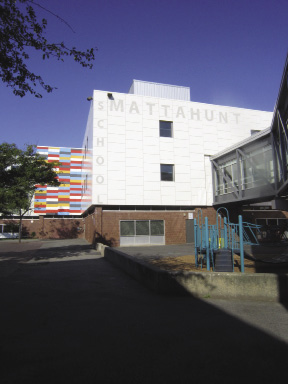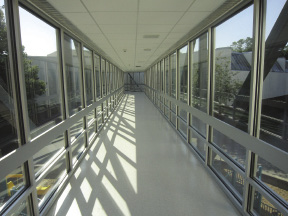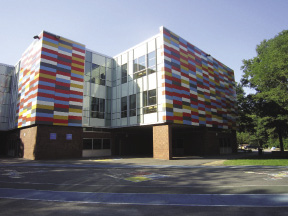After two years of design and a year and a half of construction, the redesigned Mattahunt Elementary School opened to students on September 6. This $8 million modernization project was funded by the City of Boston. Originally built in the 1960s, the school's exterior, an insulated metal panel system, was failing. The Boston Public Facilities Department (BPFD) hired Gale Associates, Inc., a building envelope consulting engineering firm, to design repairs to the building's exterior.
The three-story, 105,000 s/f Mattahunt has a masonry first floor and a white insulated metal panel system with punched windows at the second and third floors. The school is connected by a bridge to a 26,000 s/f Community Center (now administered privately by Wheelock College). The school was experiencing moisture and weatherization problems for over a decade. Gale performed field evaluations, which included destructive test cuts and an interior leak audit to assess the condition of the building envelope. The metal panels were rusting, paint was peeling, and the insulation was deteriorating inside the panels due to moisture infiltration. The metal panels were also visible on the inside of the classroom in multiple locations, giving a sterile, industrial atmosphere to the classrooms.
The existing steel pivot windows had started to sag, leaving large visible gaps between the sash and frame and allowing air infiltration. It was also impossible to fully close some of the windows, forcing the students to wear jackets on cold days. The connecting bridge was drafty and experiencing moisture infiltration from several roof penetrations and panel joints. Additionally, the main entrance door was not welcoming and there was little to indicate the school's name or entry point.
Together with Utile, Inc., an architecture and planning firm, Gale redesigned the building's exterior for weatherization, thermal performance, and visual aesthetics. The building consists of two classroom pods on each wing with a central library and administration area; the design intent was to display the internal usage on the buildings exterior. Gale and Utile provided the BPFD and School Department with several options for replacement wall systems and improved aesthetics. Gale's building enclosure design criteria emphasized the need for long-term performance, energy efficiency, and the low maintenance and durability necessary for an urban environment. The final design highlighted the classroom areas by introducing a varied colored metal panel wall system with a large curtain wall encompassing the previous punched window locations. The new design, which has been referred to as "Lego-like," was intended to add color and enliven the learning environment.
The use of a curtain wall fenestration eliminated the need for additional structural supports for individual window units. Since the curtain wall would span non-window areas, a collection of translucent, opaque, and partially opaque glass was used to provide daylight, and hide floor slabs and interior chase walls. The administration areas were treated with a larger size mono-tone colored metal panel system with punched windows. Several punched panels were used to spell Mattahunt School across the administration walls over the north and south entries to provide branding and to mark the entries. The bridge was completely re-finished with more glass and a matching color scheme. New flooring, ceilings, and lights were added to make the bridge brighter and safer for the children's use. Gale also designed the replacement of the school and community center roof systems with a multi-ply built-up roof system.
The general contractor, Reliable Roofing and Sheet Metal, phased the project through the school year to minimize disruption. Temporary classrooms were provided so that each class could be evacuate for two weeks while the contractor built a new temporary wall, including windows, while they removed the exterior wall. They then installed new metal stud framing, exterior sheathing, air and vapor barrier membranes, continuous insulation, and a new metal panel system from the exterior. The project was completed on time and on budget with minimal change orders.











.png)